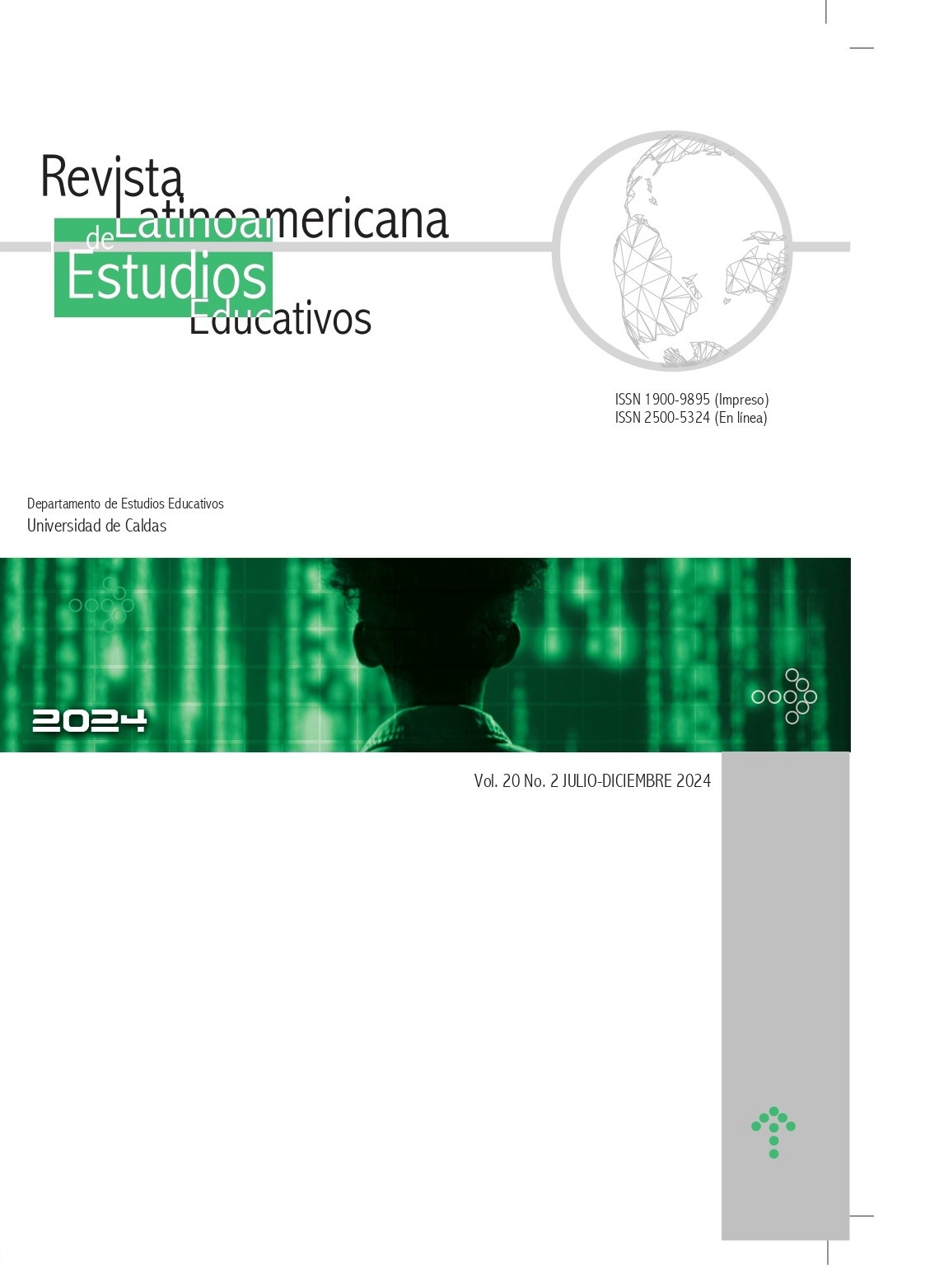Autores/as
Resumen
Comprender cómo se relacionan la motivación y el compromiso durante el aprendizaje, específicamente el aprendizaje de las matemáticas, es uno de los desafíos actuales en los estudios relacionados con las ciencias cognitivas, en particular, las ciencias del aprendizaje. El objetivo fue caracterizar las perspectivas empleadas en la investigación sobre dicha relación. Para ello, se llevó a cabo una búsqueda exhaustiva en las bases de datos Web of Science y Scopus, abarcando el período de 2013 a 2023, con criterios de inclusión centrados en el área de conocimiento, investigaciones sobre educación matemática, artículos publicados en inglés en revistas especializadas y estudios que abordaran la motivación y el compromiso en matemáticas. Aplicando estos criterios se identificaron nueve artículos relevantes mediante el uso del paquete estadístico Bibliometrix en el software R. Posteriormente, se realizó un análisis detallado de cada artículo de manera manual. Los resultados muestran que predominan los estudios multidimensionales que integran diversas dimensiones de la motivación y el compromiso, siendo estos mayoritariamente de carácter transversal y explicativo. Esta tendencia limita la comprensión de la evolución de estos constructos en los estudiantes. Los hallazgos evidencian la necesidad de realizar estudios longitudinales que permitan analizar cómo la motivación y el compromiso se desarrollan a lo largo del tiempo. Además, se destaca la importancia de utilizar técnicas cualitativas, como entrevistas o análisis de videos, que superen las limitaciones de los autoinformes y permitan observar las acciones de los estudiantes en situaciones de aprendizaje de matemáticas.
Citas
Ainley, M. (2012). Students’ Interest and Engagement in Classroom Activities. En S. L. Christenson, A. L. Reschly y C. Wylie (Eds.), Handbook of Research on Student Engagement (pp. 283-302). Springer Science y Business Media.
Anderman, E. M. y Patrick, H. (2012). Achievement Goal Theory, Conceptualization of Ability/Intelligence, and Classroom Climate. En S. L. Christenson, A. L. Reschly y C. Wylie (Eds.), Handbook of Research on Student Engagement (pp. 173.191). Springer Science y Business Media.
Capone, R. y Lepore, M. (2022). From Distance Learning to Integrated Digital Learning: A Fuzzy Cognitive Analysis Focused on Engagement, Motivation, and Participation During COVID-19 Pandemic. Technology, Knowledge and Learning, 27, 1259-1289.
Chen, S. y Lin, S. (2019). A Cross-Cultural Study of Mathematical Achievement: From the Perspectives of One’s Motivation and Problem-Solving Style. International Journal of Science and Mathematics Education, 18(6).
Chen, G., Gully, S. M., & Eden, D. (2001). Validation of a new general selfefficacy scale. Organizational Research Methods, 4(1), 62–83. https://doi.org/10.1177/109442810141004
Cleary, T. J. y Zimmerman, B. J. (2012). A Cyclical Self- Regulatory Account of Student Engagement: Theoretical Foundations and Applications. En S. L. Christenson, A. L.Reschly y C. Wylie (Eds.), Handbook of Research on Student Engagement (pp. 237-257). Springer Science y Business Media.
Collie, R. J., & Martin, A. J. (2019). Motivation and engagement in learning. Oxford Research Encyclopedia of Education.https://doi.org/10.1093/acrefore/9780190264093.013.891
Daniels, L. M., Stupnisky, R. H., Pekrun, R., Haynes, T. L., Perry, R. P., & Newall, N.E. (2009). A longitudinal analysis of achievement goals: From affective antecedents to emotional effects and achievement outcomes. Journal of Educational Psychology, 101(4), 948–963. https://doi.org/10.1037/a0016096
Duckworth, A. L., Peterson, C., Matthews, M. D., & Kelly, D. R. (2007). Grit: Perseverance and passion for long-term goals. Journal of Personality and Social Psychology, 92(6), 1087–1101. https://doi.org/10.1037/0022-3514.92.6.1087
Durksen, T., Way, J., Bobis, J., Anderson, J., Skilling, K. y Martin, A. J. (2017). Motivation and Engagement in Mathematics: A Qualitative Framework for Teacher-Student Interactions. Mathematics Education Research Journal, 29(2).
Eccles, J. S. y Wigfield, A. (2002). Motivational Beliefs, Values, and Goals. Annual Review of Psychology, 53(1), 109-132.
Fredricks, J. A., Blumenfeld, P. C. y Paris, A. H. (2004). School Engagement: Potential of the Concept, State of the Evidence. Review of educational research, 74(1), 59-109.
Fredricks, J. A., Hofkens, T. L., Wang, M. T., Renninger, K. A. y Hidi, S. E. (2019). Addressing the Challenge of Measuring Student Engagement. En The Cambridge Handbook of Motivation and Learning (pp. 689-712). Cambridge University Press.
Fredricks, J. A., Wang, M. T., Linn, J. S., Hofkens, T. L., Sung, H., Parr, A. y Allerton, J. (2016). Using Qualitative Methods to Develop a Survey Measure of Math and Science Engagement. Learning and Instruction, 43, 5-15.
González-Tobón, J., Tellez-Bohorquez F. A. y Tamayo, O. (9-12 de julio de 2019). Metacognition in the Wild: Metacognitive Studies in Design Education. Insider Knowledge, DRS Learn X Design Conference, Ankara, Turquía.
Green, J., Martin, A. J. y Marsh, H. (2007). Motivation and Engagement in English, Mathematics and Science High School Subjects: Towards an Understanding of Multidimensional Domain Specificity. Learning and Individual differences, 17(3), 269-279.
Greeno, J. G. (1998). The situativity of knowing, learning, and research. American Psychologist, 53(1), 5–26. https://doi.org/10.1037/0003-066X.53.1.5
Hidi, S. E. y Renninger, K. A. (2019). Motivation and its Relation to Learning. The Cambridge handbook of motivation and learning (pp. 1-11).
Kim, C., Park, S. W., Cozart, J. y Lee, H. (2015). From Motivation to Engagement: The Role of Effort Regulation of Virtual High School Students in Mathematics Courses. Journal of Educational Technology & Society, 18(4), 261-272.
Kong, S. C., Wong, T. L., & Lam, C. C. (2003). Student engagement in mathematics: Development of instrument and validation of construct. Educational Psychology, 23(1), 55–72. https://doi.org/10.1080/0144341030322
Lee, H., & Kim, Y. (2014). Korean adolescents’ longitudinal change of intrinsic motivation in learning English and mathematics during secondary school years: Focusing on gender difference and school characteristics. Learning and Individual Differences, 36, 131–139. https://doi.org/10.1016/j.lindif.2014.07.018
Liu, Q., Du, X., Zhao, S., Liu, J., & Cai, J. (2019a). The role of memorization in students’ self-reported mathematics learning: A large-scale study of Chinese eighth-grade students. Asia Pacific Education Review, 20(3), 361–374. https://doi.org/10.1007/s12564-019-09576-2
Liu, Y., Hau, K. T., & Zheng, X. (2019). Do both intrinsic and identified motivations have long-term effects? The Journal of Psychology, 153(3), 288–306. https://doi.org/10.10 80/00223980.2018.1516611
Martin, A. J. (2003). The Student Motivation Scale: Further Testing of an Instrument that Measures School Students' motivation. Australian journal of Education, 47(1), 88-106.
Martin, A. J. (2007). Examining a Multidimensional Model of Student Motivation and Engagement Using a Construct Validation Approach. The British Journal of Educational Psychology, 77(Pt 2), 413-440.
Martin, A. J. (2009). Motivation and engagement across the academic life span: A developmental construct validity study of elementary school, high school, and university/college students. Educational and Psychological Measurement, 69(5),794–824. https://doi.org/10.1177/0013164409332214
Martin, A. J. (2012). Part II Commentary: Motivation and Engagement: Conceptual, Operational, and Empirical Clarity. En S. L. Christenson, A. L. Reschly y C. Wylie (Eds.), Handbook of Research on Student Engagement (pp. 303-311). Springer Science y Business Media.
Martin, A. J. y Hau, K. T. (2010). Achievement Motivation among Chinese and Australian School Students: Assessing Differences of Kind and Differences of Degree. International Journal of Testing, 10(3), 274-294.
Martin, A. J., Ginns, P. y Papworth, B. (2017). Motivation and Engagement: Same or Different? Does it matter? Learning and individual differences, 55(150), 162.
Martin, A. J., Martin, T. G. y Evans, P. (2016). Motivation and Engagement in Jamaica: Testing a Multidimensional Framework Among Students in an Emerging Regional Context. Journal of Psychoeducational Assessment, 36(3), 233-248.
Martin, D. P. y Rimm-Kaufman, S. E. (2015). Do Student Self-Efficacy and Teacher-Student Interaction Quality Contribute to Emotional and Social Engagement in Fifth Grade Math? Journal of School Psychology, 53(5), 359-373.
Murayama, K., Pekrun, R., Lichtenfeld, S. y vom Hofe, R. (2013). Predicting Long-Term Growth in Students’ Mathematics Achievement: The Unique Contributions of Motivation and Cognitive Strategies. Child Development, 84(4), 1475-1490.
Murayama, K., Renninger, K. y Hidi, S. (2019). Neuroscientific and Psychological Approaches to Incentives: Commonality and Multifaceted Views. En The Cambridge Handbook of Motivation and Learning (pp. 141-162). Cambridge University Press.
Nolen, S. (2019). Conceptualizing Goals in Motivation and Engagement. En K. Renninger y S. Hidi (Eds.), The Cambridge Handbook of Motivation and Learning (pp. 547-565). Cambridge University Press.
Page, M. J., McKenzie, J. E., Bossuyt, P. M., Boutron, I., Hoffmann, T. C., Mulrow, C. D., Shamseer, L., Tetzlaff, J. M., Akl, E. A., Brennan, S. E., Chou, R., Glanville, J., Grimshaw, J. M., Hróbjartsson, A., Lalu, M. M., Li, T., Loder, E. W., Mayo-Wilson, E., McDonald, S... Fernández, S. (2021). Declaración PRISMA 2020: una guía actualizada para la publicación de revisiones sistemáticas. Revista Española de Cardiología, 74(9), 790-799.
Pekrun, R., Goetz, T., & Frenzel, A. C. (2005). Achievement Emotions Questionnaire—Mathematics (AEQ-M): User’s Manual. Department of Psychology, University of Munich.
Pekrun, R. y Linnenbrink-Garcia, L. (2012). Academic Emotions and Student Engagement. En S. L. Christenson, A. L. Reschly y C. Wylie (Eds.), Handbook of Research on Student Engagement (pp. 259-282). Springer Science y Business Media.
Pintrich, P. R., & De Groot, E. V. (1990). Motivational and self-regulated learning components of classroom academic performance. Journal of Educational Psychology, 82(1), 33–40. https://doi.org/10.1037/0022-0663.82.1.33
Pintrich, P. R. (2003). A Motivational Science Perspective on the Role of Student Motivation in Learning and Teaching Contexts. Journal of Educational Psychology, 95(4), 667-686.
Pintrich, P. R. y Schunk, H. (2002). Motivation in education: Theory, Research, and Pintrich, P. R., Smith, D. A., Garcia, T. y McKeachie, W. J. (1993). Reliability and Predictive Validity of the Motivated Strategies for Learning Questionnaire (MSLQ). Educational and Psychological Measurement, 53(3), 801-813.
Plenty, S. y Heubeck, B. G. (2013). A Multidimensional Analysis of Changes in Mathematics Motivation and Engagement During High School. Educational Psychology, 33(1), 14-30.
Reeve, J. (2012). A Self-Determination Theory Perspective on Student Engagement. En S. L. Christenson, A. L. Reschly y C. Wylie (Eds.), Handbook of Research on Student Engagement (pp. 149-172). Springer Science and Business Media.
Reeve, J. y Tseng, C. M. (2011). Agency as a Fourth Aspect of Students’ Engagement During Learning Activities. Fuel and Energy Abstracts, 36(4), 257-267.
Roche, A., Gervasoni, A. y Kalogeropoulos, P. (2021). Factors that Promote Interest and Engagement in Learning Mathematics for Low-Achieving Primary Students Across Three Learning Settings. Mathematics Education Research Journal, 35(3), 1-32.
Ryan, R. M. y Bradshaw, E. L. (2019). Envisioning Progress and Perils: Musings on the Future of Motivation Research in a Rapidly Evolving World. En R. M. Ryan (Ed.), The Oxford Handbook of Human Motivation (pp. 527-532). Oxford University Press.
Ross, J. A., McDougall, D., Hogaboam-Gray, A., & LeSage, A. (2003). A survey
measuring elementary teachers’ implementation of standards-based mathematics teaching. Journal for Research in Mathematics Education, 34(4), 344–363. https://doi.org/10.2307/30034787
Schunk, D. H. y Mullen, C. A. (2012). Self-Efficacy as an Engaged Learner. En S. L.Christenson, A. L. Reschly y C. Wylie (Eds.), Handbook of Research on Student Engagement (pp. 219-235). Springer Science and Business Media.
Skilling, K., Bobis, J. y Martin, A. J. (2021). The “Ins and Outs” of Student Engagement in Mathematics Shifts in Engagement Factors Among High and Low Achievers. Mathematics Education Research Journal, 33(3), 469-493.
Skinner, E. A. (2016). Engagement and Disaffection as Central to Processes of Motivational Resilience and Development. Handbook of Motivation at School (pp. 145-168).Routledge.
Skinner, E. A., Kindermann, T. A., Connell, J. P. y Wellborn, J. G. (2009). Engagement and Disaffection as Organizational Constructs in the Dynamics of Motivational Development. En K. R. Wenzel y A. Wigfield (Eds.), Handbook of Motivation at School (pp. 223- 245). Routledge y Taylor and Francis Group.
Solomon, H. y Anderman, E. M. (2016). Learning with Motivation. En P. Alexander y R.Mayer (Eds.), Handbook of Learning and Instruction (pp. 258-282). Routledge.
Wang, M. T., Fredricks, J. A., Ye, F., Hofkens, T. L. y Linn, J. (2016). The Math and Science Engagement Scales: Scale Development, Validation, and Psychometric Properties.Learning and Instruction, 43, 16-26.
Xia, Q., Yin, H., Hu, R., Li, X. y Shang, J. (2022). Motivation, Engagement, and Mathematics Achievement: An Exploratory Study among Chinese Primary Students. SAGE Open, 12(4).
Zhang, Y., Yang, X., Sun, X. y Kaiser, G. (2023). The Reciprocal Relationship among Chinese Senior Secondary Students’ Intrinsic and Extrinsic Motivation and Cognitive Engagement in Learning Mathematics: A Three-Wave Longitudinal Study. ZDM–Mathematics Education, 55, 399-412.
Zhu, Y. (2021). What Can PISA Tell Us About Students’ Mathematics Learning in Shanghai, China? En B. Xu, Y. Zhu y X. Lu (Eds.), Beyond Shanghai and PISA (pp. 15-32). Springer.
Zhu, Y. y Leung, F. (2010). Motivation and Achievement: Is There an East Asian Model? International Journal of Science and Mathematics Education, 9(5), 1189-1212.
Zupic, I. y Čater, T. (2014). Bibliometric Methods in Management and Organization.Organizational Research Methods, 18(3), 429-472.

 PDF
PDF
 FLIP
FLIP
























